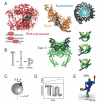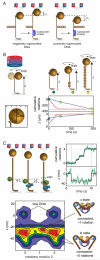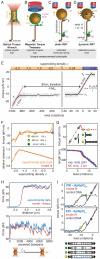Recent developments in single-molecule DNA mechanics
- PMID: 22658779
- PMCID: PMC3726534
- DOI: 10.1016/j.sbi.2012.04.007
Recent developments in single-molecule DNA mechanics
Abstract
Over the past two decades, measurements on individual stretched and twisted DNA molecules have helped define the basic elastic properties of the double helix and enabled real-time functional assays of DNA-associated molecular machines. Recently, new magnetic tweezers approaches for simultaneously measuring freely fluctuating twist and extension have begun to shed light on the structural dynamics of large nucleoprotein complexes. Related technical advances have facilitated direct measurements of DNA torque, contributing to a better understanding of abrupt structural transitions in mechanically stressed DNA. The new measurements have also been exploited in studies that hint at a developing synergistic relationship between single-molecule manipulation and structural DNA nanotechnology.
Copyright © 2012 Elsevier Ltd. All rights reserved.
Figures



 (where l is the length of the DNA and Pt,eff is the effective twist persistence length). Δθ0,L, extrapolated change in twist per basepair for the B-L transition; N, number of basepairs of DNA; κL, torsional spring constant for L-DNA. Data are from [26], obtained using dynamic RBT. F) Torque and extension for a complete B-to-L transition measured using an optical torque wrench, and global fit to an analytical model[34]. G) Torque and extension at the plectonemic buckling transition. Extension data are shown together with simulated extension and simulated torque[30]. H) Sequence dependent unpeeling of dsDNA under extension[40], shown together with an equilibrium model based on known basepair stabilities. I) The torsional response of GC repeats[26] is explained by cooperative B-Z transitions. In the depicted microstates, energetically costly junctions between B-form and Z-form are shown as yellow bars.
(where l is the length of the DNA and Pt,eff is the effective twist persistence length). Δθ0,L, extrapolated change in twist per basepair for the B-L transition; N, number of basepairs of DNA; κL, torsional spring constant for L-DNA. Data are from [26], obtained using dynamic RBT. F) Torque and extension for a complete B-to-L transition measured using an optical torque wrench, and global fit to an analytical model[34]. G) Torque and extension at the plectonemic buckling transition. Extension data are shown together with simulated extension and simulated torque[30]. H) Sequence dependent unpeeling of dsDNA under extension[40], shown together with an equilibrium model based on known basepair stabilities. I) The torsional response of GC repeats[26] is explained by cooperative B-Z transitions. In the depicted microstates, energetically costly junctions between B-form and Z-form are shown as yellow bars.
Similar articles
-
Gold rotor bead tracking for high-speed measurements of DNA twist, torque and extension.Nat Methods. 2014 Apr;11(4):456-62. doi: 10.1038/nmeth.2854. Epub 2014 Feb 23. Nat Methods. 2014. PMID: 24562422 Free PMC article.
-
Multi-parameter measurements of conformational dynamics in nucleic acids and nucleoprotein complexes.Methods. 2019 Oct 1;169:69-77. doi: 10.1016/j.ymeth.2019.06.019. Epub 2019 Jun 19. Methods. 2019. PMID: 31228549 Review.
-
Probing the mechanical properties, conformational changes, and interactions of nucleic acids with magnetic tweezers.J Struct Biol. 2017 Jan;197(1):26-36. doi: 10.1016/j.jsb.2016.06.022. Epub 2016 Jun 29. J Struct Biol. 2017. PMID: 27368129 Review.
-
Structural transitions and elasticity from torque measurements on DNA.Nature. 2003 Jul 17;424(6946):338-41. doi: 10.1038/nature01810. Nature. 2003. PMID: 12867987
-
Blind predictions of DNA and RNA tweezers experiments with force and torque.PLoS Comput Biol. 2014 Aug 7;10(8):e1003756. doi: 10.1371/journal.pcbi.1003756. eCollection 2014 Aug. PLoS Comput Biol. 2014. PMID: 25102226 Free PMC article.
Cited by
-
Quantifying the Precision of Single-Molecule Torque and Twist Measurements Using Allan Variance.Biophys J. 2018 Apr 24;114(8):1970-1979. doi: 10.1016/j.bpj.2018.02.039. Biophys J. 2018. PMID: 29694873 Free PMC article.
-
Magnetic tweezers for the measurement of twist and torque.J Vis Exp. 2014 May 19;(87):51503. doi: 10.3791/51503. J Vis Exp. 2014. PMID: 24894412 Free PMC article.
-
Explaining the striking difference in twist-stretch coupling between DNA and RNA: A comparative molecular dynamics analysis.Nucleic Acids Res. 2015 Dec 2;43(21):10143-56. doi: 10.1093/nar/gkv1028. Epub 2015 Oct 12. Nucleic Acids Res. 2015. PMID: 26464435 Free PMC article.
-
Kinetic Study of DNA Topoisomerases by Supercoiling-Dependent Fluorescence Quenching.ACS Omega. 2019 Oct 24;4(19):18413-18422. doi: 10.1021/acsomega.9b02676. eCollection 2019 Nov 5. ACS Omega. 2019. PMID: 31720544 Free PMC article.
-
Gold rotor bead tracking for high-speed measurements of DNA twist, torque and extension.Nat Methods. 2014 Apr;11(4):456-62. doi: 10.1038/nmeth.2854. Epub 2014 Feb 23. Nat Methods. 2014. PMID: 24562422 Free PMC article.
References
-
- Bustamante C, Bryant Z, Smith SB. Ten years of tension: Single-molecule DNA mechanics. Nature. 2003;421(6921):423–427. - PubMed
-
-
Vijayan V, Zuzow R, O’Shea EK. Oscillations in supercoiling drive circadian gene expression in cyanobacteria. Proc Natl Acad Sci U S A. 2009;106(52):22564–22568. A dramatic demonstration of an organism using mechanical stress in DNA to control complex global changes in transcriptional profiles. The physical basis for differing promoter responses, which are only hinted at by observed sequence biases, deserves further study.
-
Publication types
MeSH terms
Substances
Grants and funding
LinkOut - more resources
Full Text Sources
Miscellaneous

